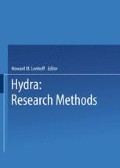Abstract
To present culture and analytical methods for research on hydras and their associated ectoparasitic fauna, with special emphasis on the use of the hydra—Hydramoeba system as a model for epizootilogical investigations. I use the term epizootic to characterize the dynamics of infectious disease in host populations (Tanada, 1963).
Access this chapter
Tax calculation will be finalised at checkout
Purchases are for personal use only
Preview
Unable to display preview. Download preview PDF.
References
Bailey,N. T. J. 1957,The Mathematical Theory of Epidemics.Hafner,New York
Bryden, R. R. 1952. Ecology of Pelmatohydra oligactis in Kirpatricks Lake, Tennessee. Ecol, Monogr, 22: 45–68.
Coleman, D. C. 1966. The laboratory population ecology of Kerona pediculus (O.E.M.) epizoic on Hydra spp. Ecology 47: 703–711.
Fulton, J. F. 1923, Trichodina pediculus and a new closely related species. Proc. Boston Soc. Nat. Hist. 37: 1–30.
Lenhoff, H. M., and Loomis, W. F. 1961. The Biology of Hydra and Some Other Coelenterates. University of Miami Press, Coral Gables, Fia.
Loomis, W. F. 1953. The cultivation of Hydra under controlled conditions. Science 117: 565–566.
Muscatine, L., and Lenhoff, H. M. 1965. Symbiosis of hydra and algae. I. Effects of some environmental cations on growth of symbiotic and aposymbiotic hydra. Biol. Bull. 128: 425–424.
Slobodkin, L. B. 1964. Experimental populations of Hydrida. J. Am. Ecol. Sappl. 33: 131–148.
Stiven, A. E. 1964. Experimental studies on the epidemiology of the host parasite system, hydra and Hydramoeba hydroxena (Entz). IL The components of a simple epidemic. Ecol.Monogr. 34: 119–142.
Stiven, A. E. 1971. The spread of Hydramoeba infections in sa ixed hydra species systems. Oecologia 6: 118–132.
Stiven, A. E. 1973. Hydra-hydramoeba: A model system for the study of epizootic processes. Curr. Top. Comp. Pathobiol. 2: 146–212.
Tanada, Y. 1963. Epizootiology of infectious diseases. Insect Pathol. 2:423–463
Yeatman, Harry C. 1965. Ecological relations of the ciliate Kerona to its host Hydra. Turtox News 43: 226–227.
Author information
Authors and Affiliations
Editor information
Editors and Affiliations
Rights and permissions
Copyright information
© 1983 Springer Science+Business Media New York
About this chapter
Cite this chapter
Stiven, A.E. (1983). Experimental Methods for Epizootilogical Research with Hydras. In: Lenhoff, H.M. (eds) Hydra: Research Methods. Springer, Boston, MA. https://doi.org/10.1007/978-1-4757-0596-6_60
Download citation
DOI: https://doi.org/10.1007/978-1-4757-0596-6_60
Publisher Name: Springer, Boston, MA
Print ISBN: 978-1-4757-0598-0
Online ISBN: 978-1-4757-0596-6
eBook Packages: Springer Book Archive

